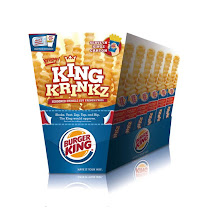Today is Black Friday, traditionally the biggest retailing day of the year, and the start of the Christmas buying season.
Functional foods— food that contains added vitamins, minerals, anti-oxidants, etc.— are big business.
Functional foods— food that contains added vitamins, minerals, anti-oxidants, etc.— are big business.
According to the research giant Packaged Facts, they already comprise a $30.7bn market with predictions of 40% growth during the next five years. Mintel’s Global New Products Database tracked 68% new products over the past two years that were fortified with omega-3 (over 1,550 items). The products included orange juice, cereal, bread and peanut butter.
But these so-called “Frankenfoods” are raising concerns among scientists and dieticians over their true effectiveness. After all, most doctors will tell you that vitamin and mineral supplements, despite their popularity, rarely deliver anything approaching the benefits derived from naturally-occurring ones that come from eating a balanced diet. There is also concern about the cost-benefit ratio in fortified foods: a two-tablespoon serving of Hearts and Minds Peanut Butter with Omega-3 and Olive Oil has 100 mg of the beneficial omega-3, while a 3.5 oz. portion of salmon or other oily fish has 1,500 mg. A single slice of Wonder Classic Calcium Fortified Enriched Bread has only 10% of the daily recommended value, whereas a cup of milk has 30%.
The concept of using foods to deliver health additives began in 1924 when iodine was added to salt in the state of Michigan to fight goiter. The experiment spread to the rest of the country, and led to other additives, including niacin thiamin, riboflavin and iron in 1943 for breads and grains, which stamped out pellagra, a disease that ravaged the brain and skin, but which is unknown now. In 1998, the U.S. Food and Drug Administration (FDA) required adding folic acid to enriched grains in breads and cereals hoping to fight neural-tube defects in the unborn. A 25% reduction in infants born with the condition has been credited to the move, though some researchers are concerned too much folic acid can be toxic.
One advantage of dispensing additives in food over taking supplements is many are fat-soluble, meaning the body digests them better taken with food. There is also the fact that ¾ of Americans don’t reach the U.S. recommended daily allowance for vitamins and nutrients. Including them in food insures they are ingested, though processing destroys nutrients, so eating food in an unprocessed form is preferable. Protein-fortified pasta, for example, contains as much protein as meat, though they have higher simple carbohydrates, which contribute to obesity.
Additives may provide “cover,” too, for unhealthy foods. Is a bag of potato chips containing fiber mean it’s more than empty calories? Sports drinks provide nutrients but are overloaded with sugar, something the beverage industry plays down and most consumers ignore. Since the FDA does not regulate probiotics, omega-3 or other nutrients, manufacturers are not required to tell consumers the amount contained in their foods or whether it’s a lot or a little. Yet in the end, researchers concede fortified processed food is generally better than unfortified processed food.
This blog includes excerpts from a weekly round-up of food industry & food licensing news provided free to Broad Street Licensing Group's clients, and as a paid subscription service (6 months $695; 1 year $1,125). Too busy to keep up with the news wires & publications about the food business? If you or your company would like to subscribe to our news service, call Danielle Foley at Broad Street Licensing Group (tel. 973-655-0598) and ask for your free sample or click on our website.
This blog includes excerpts from a weekly round-up of food industry & food licensing news provided free to Broad Street Licensing Group's clients, and as a paid subscription service (6 months $695; 1 year $1,125). Too busy to keep up with the news wires & publications about the food business? If you or your company would like to subscribe to our news service, call Danielle Foley at Broad Street Licensing Group (tel. 973-655-0598) and ask for your free sample or click on our website.
.gif)











No comments:
Post a Comment
Note: Only a member of this blog may post a comment.